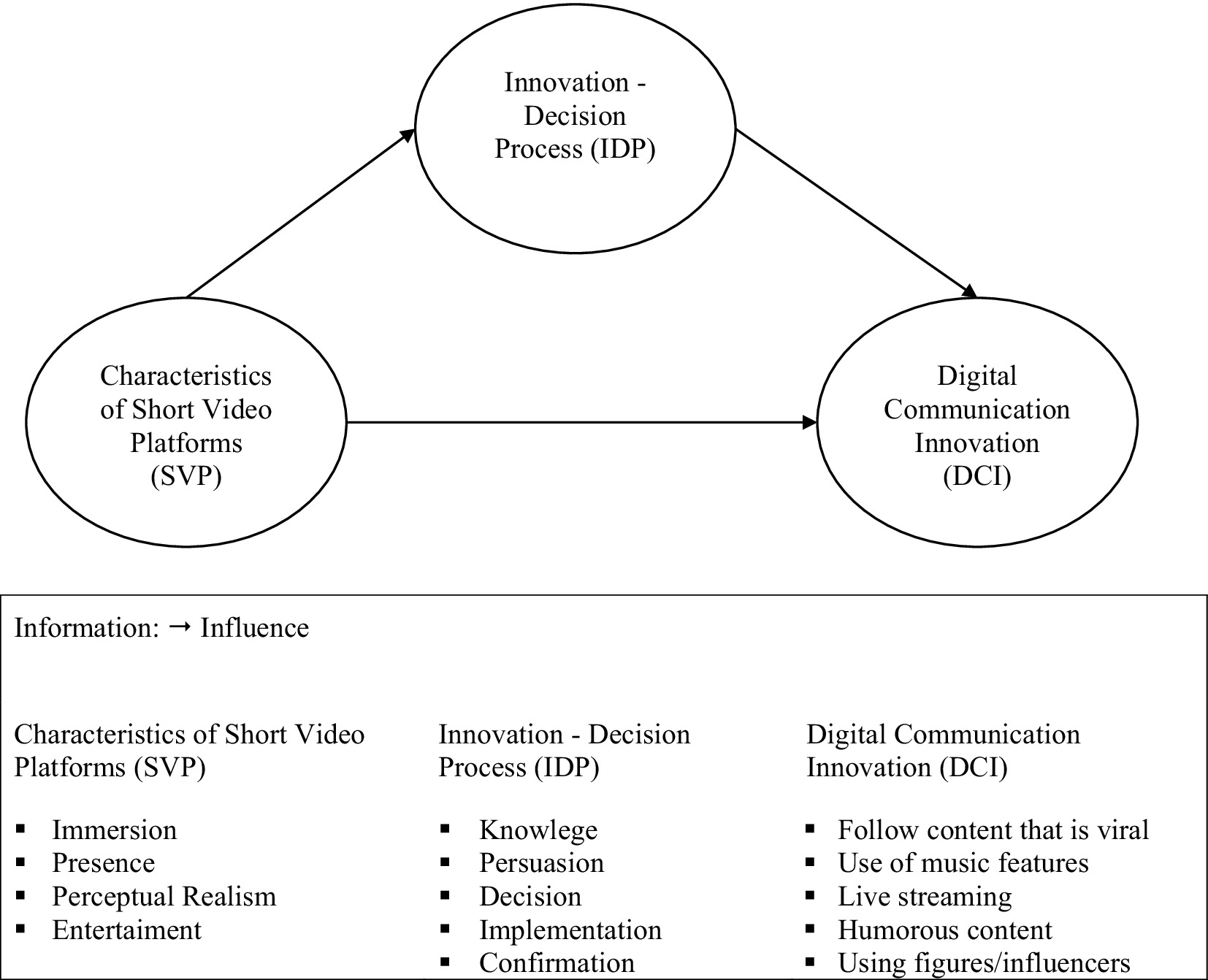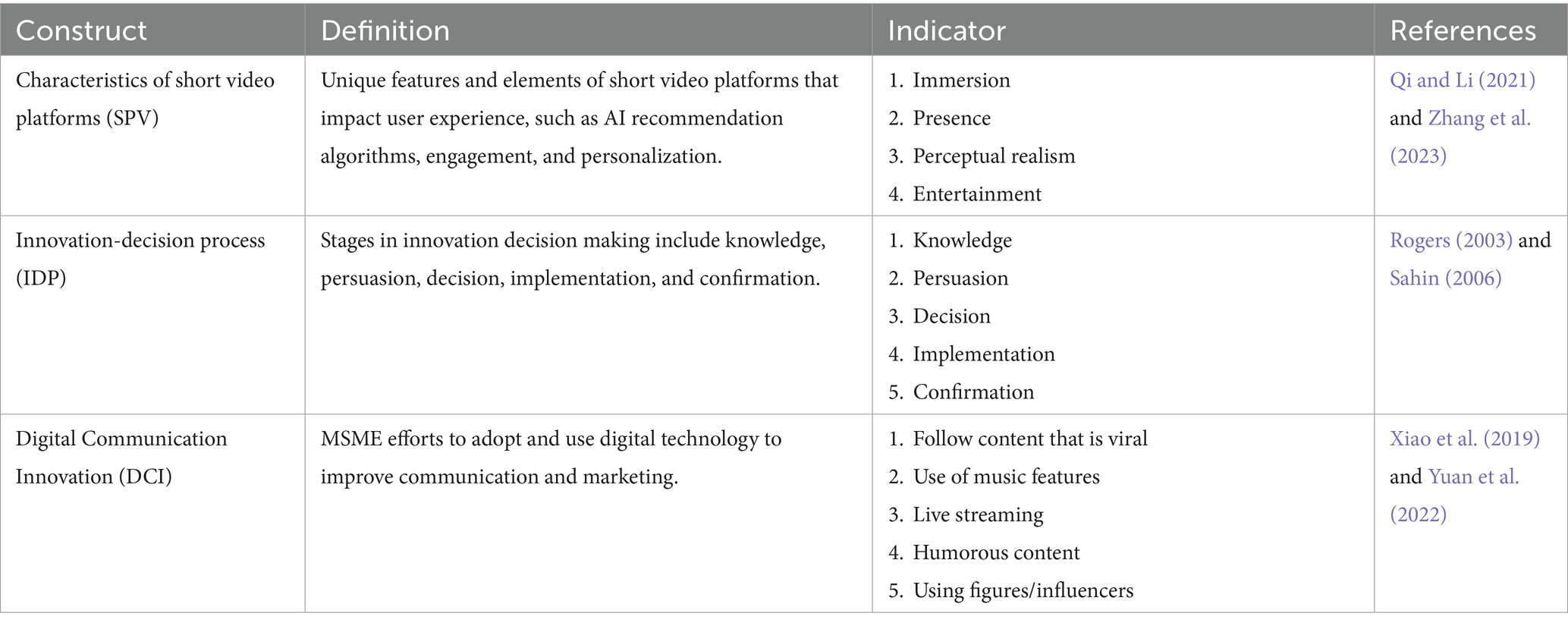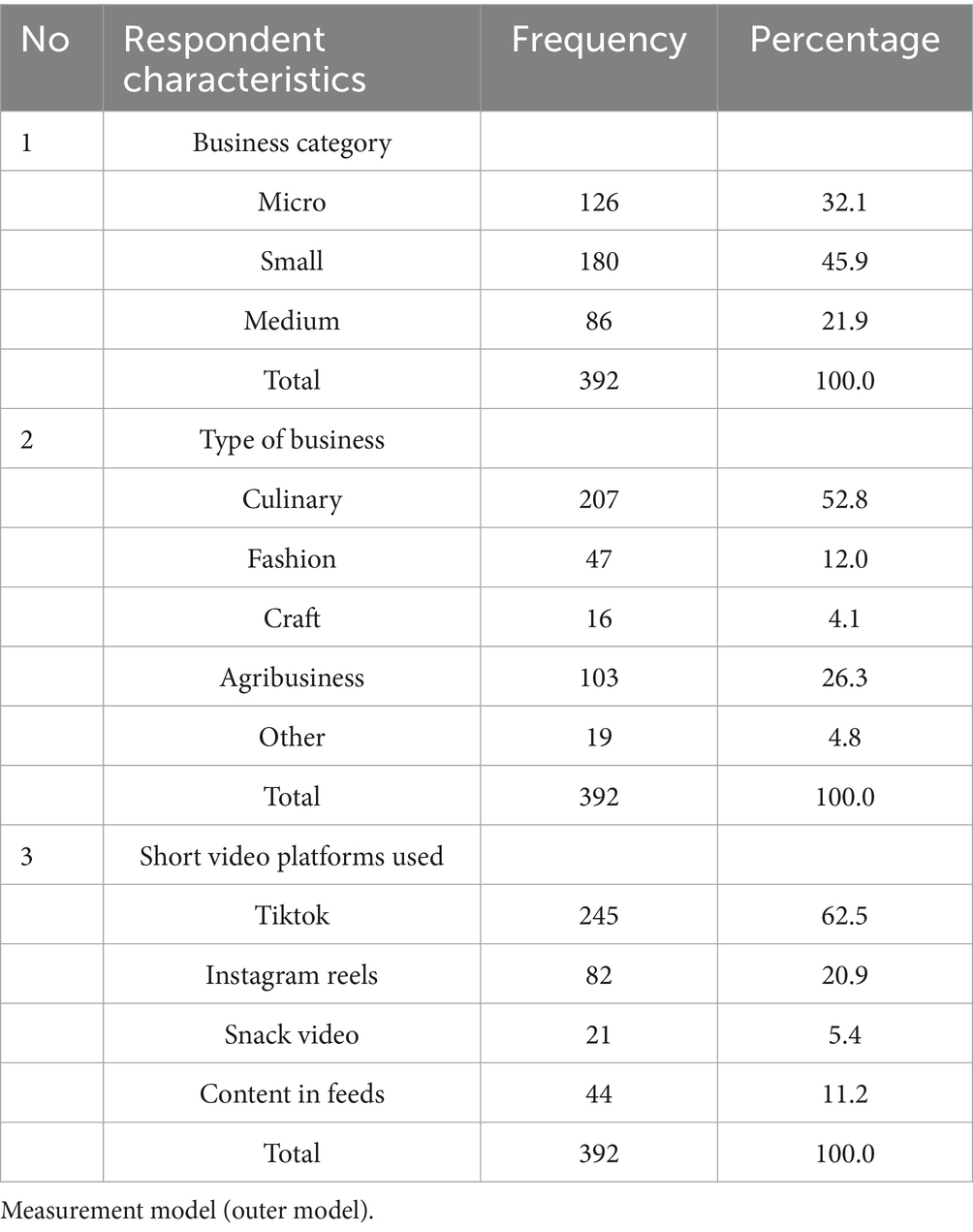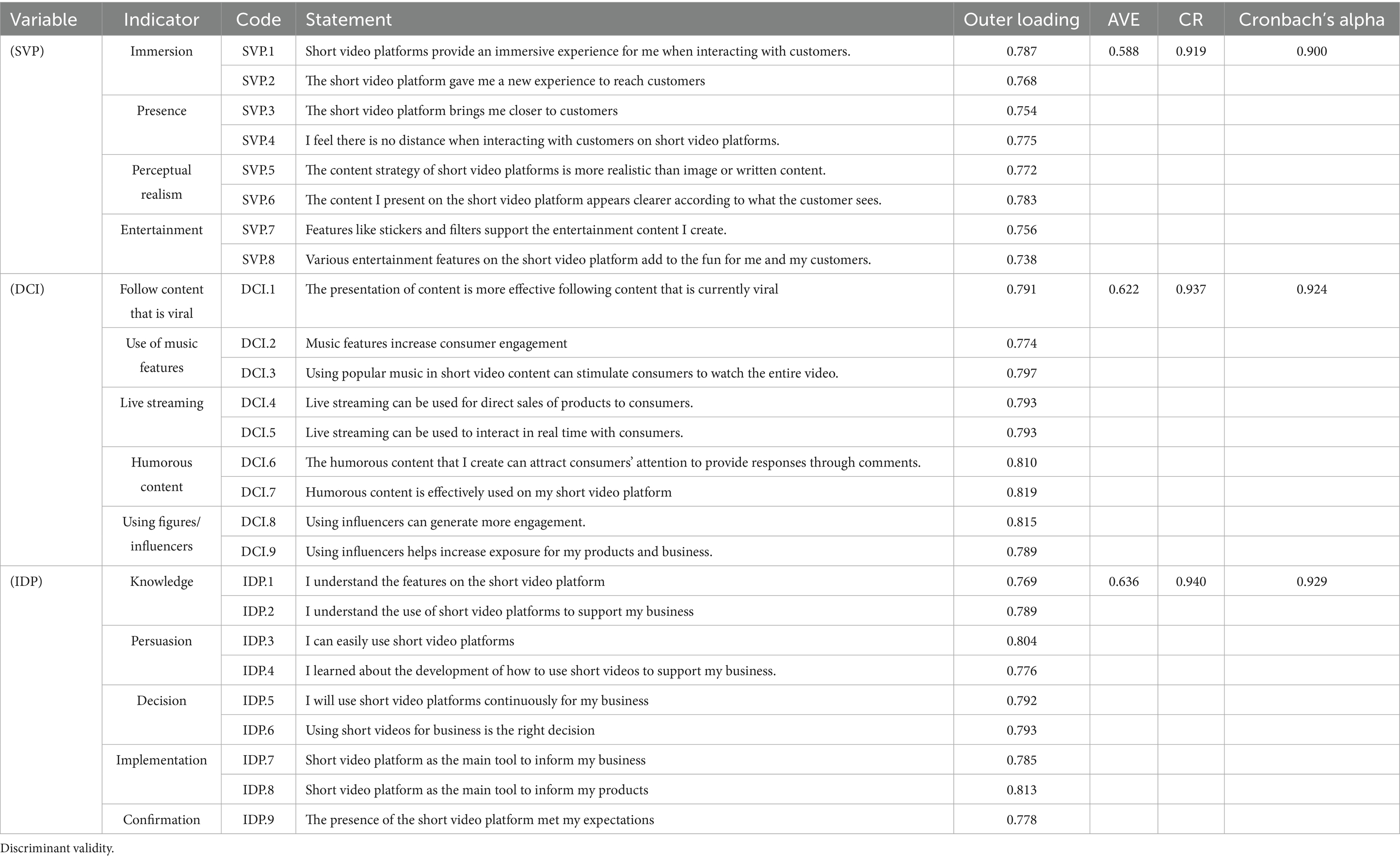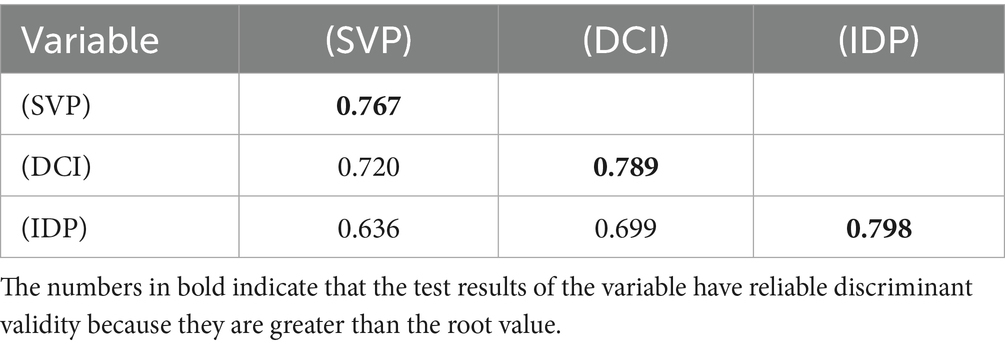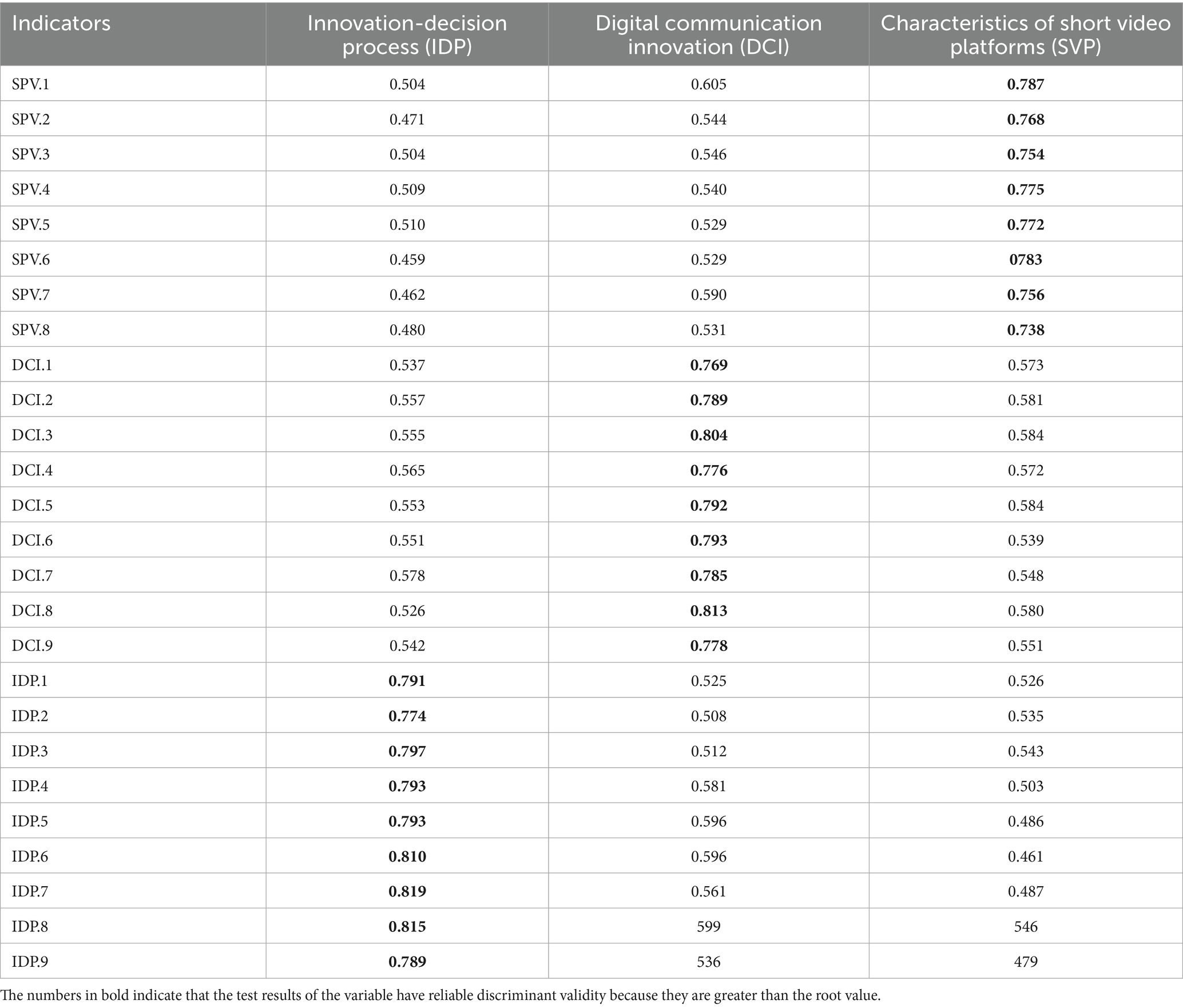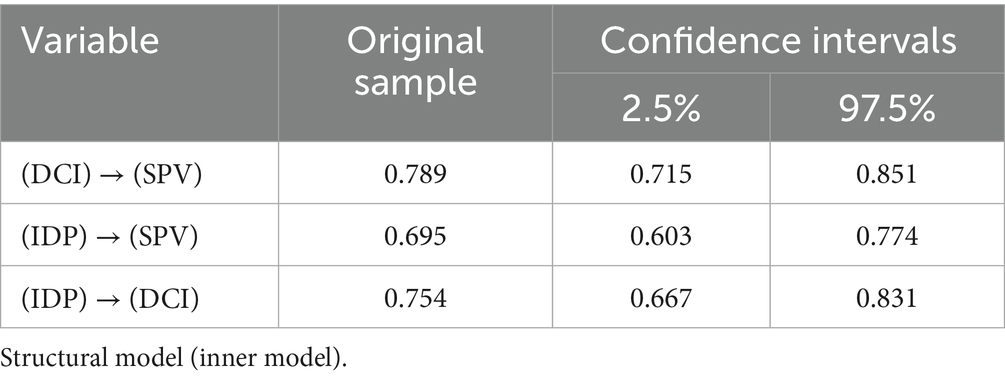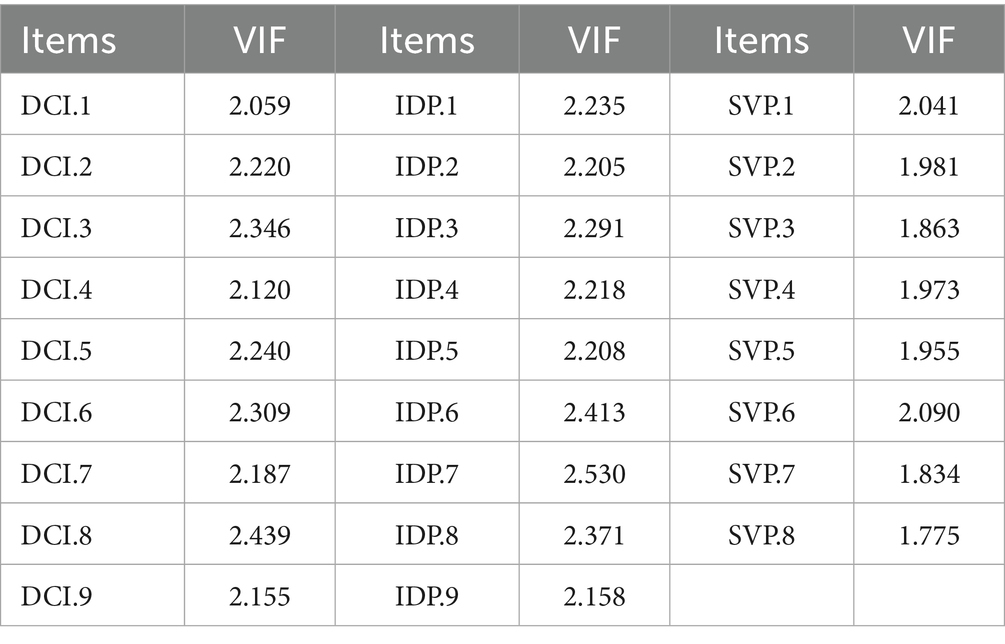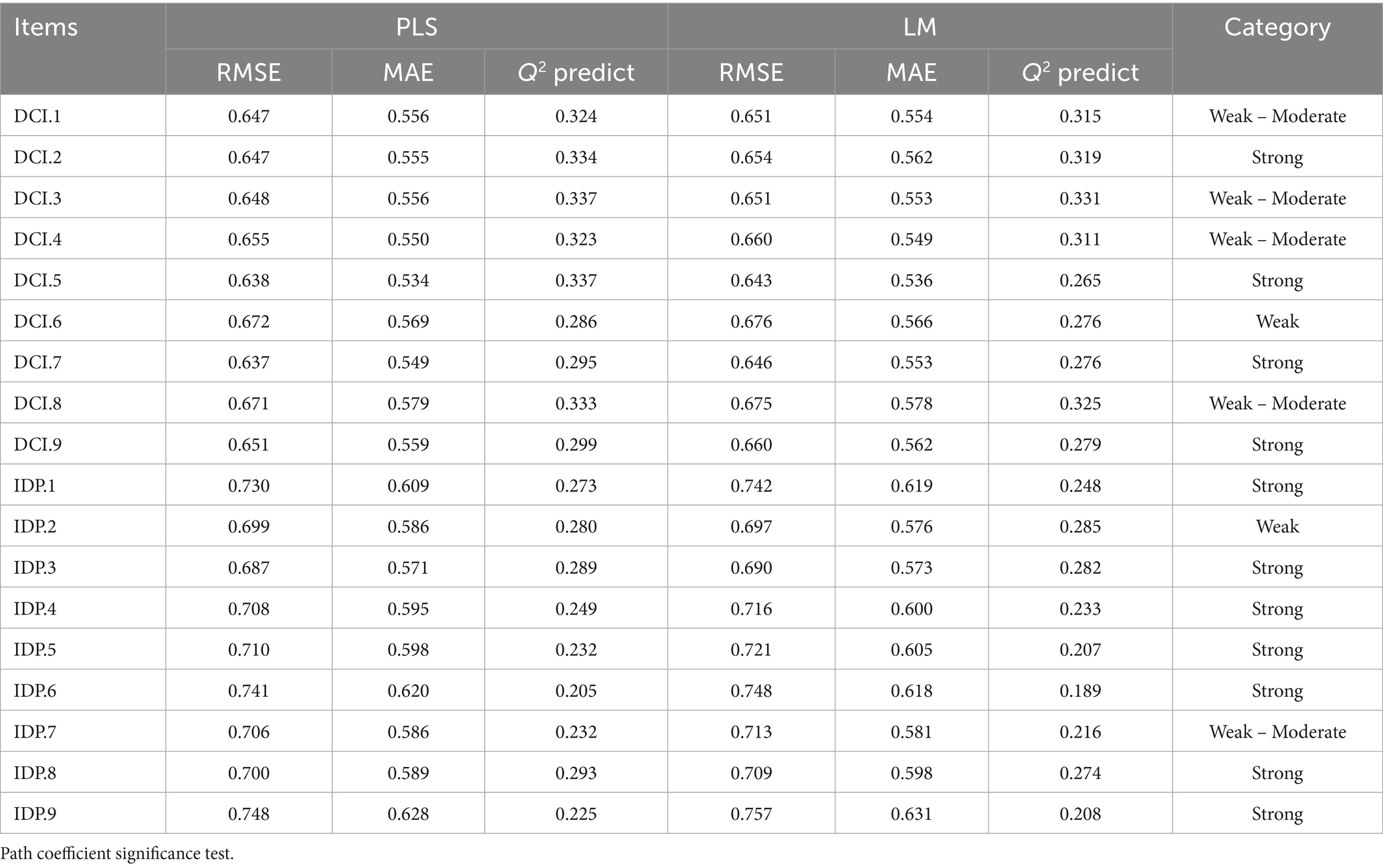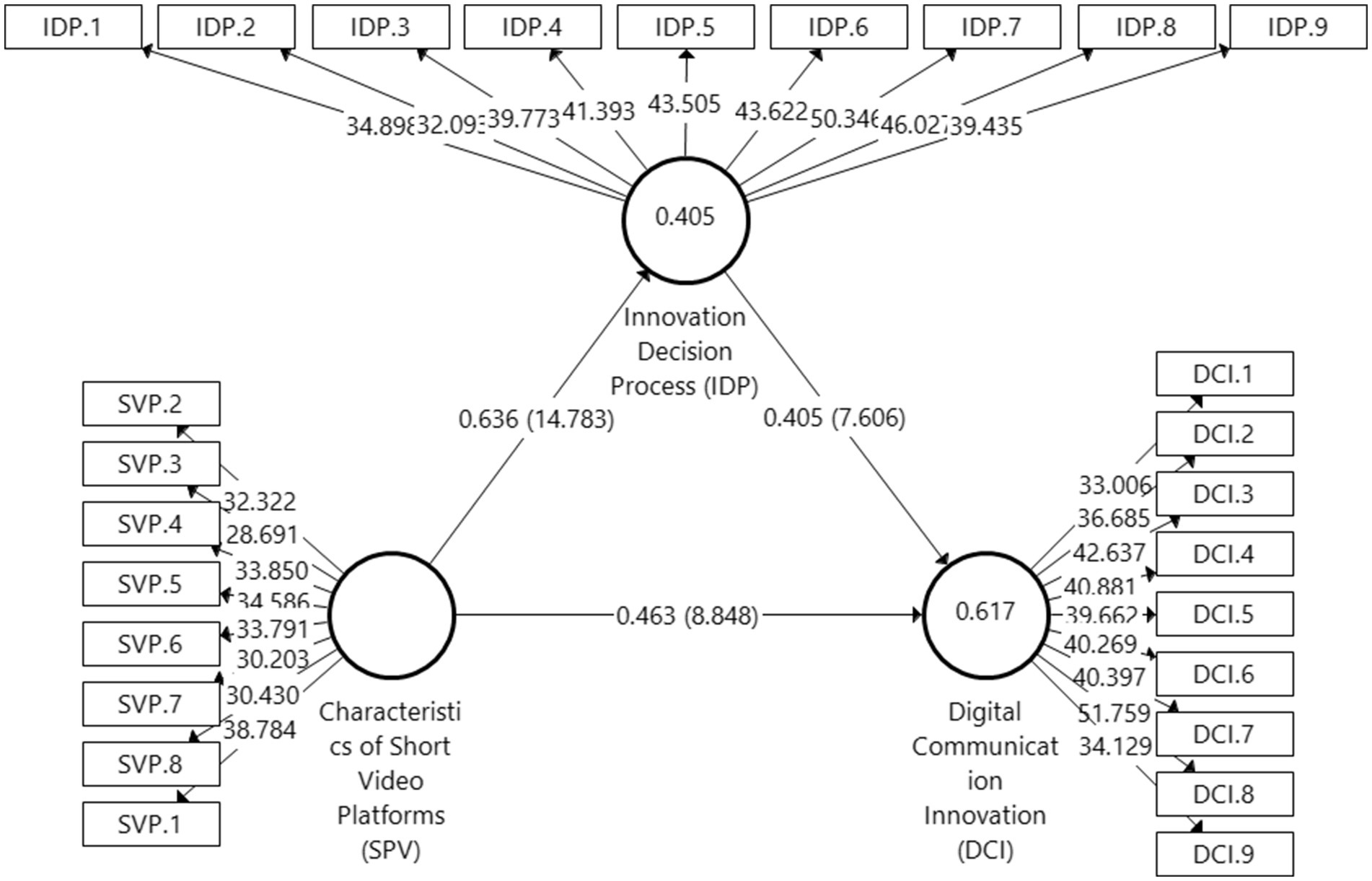- 1Department of Communication Science, Telkom University, Bandung, Indonesia
- 2Department of Public Relation, Telkom University, Bandung, Indonesia
Short video platforms such as TikTok, Instagram Reels, and YouTube Shorts have quickly become central to digital communication strategies, particularly for micro, small, and medium enterprises (MSMEs). Compared with previous social media platforms, short video platforms possess unique affordances, such as visibility, virality, multimodal expression, and low-cost experimentation, enabling MSMEs to innovate in digital communication. Although prior research has extensively examined the adoption of short video platforms, the specific mechanisms by which these affordances shape the innovation-decision processes of MSMEs are still rarely explored. This study formalizes the short video platforms affordance of digital communication innovation pathways through innovation-decision process, bridging affordance theory with UTAUT2 and diffusion of innovation perspectives, thereby extending social media innovation literature in the MSMEs context. The research method used survey data from MSMEs in Bandung Regency, Indonesia, using Likert-scale measurements on 392 MSMEs and SEM-PLS analysis. The findings suggest that short video platforms have a positive impact on digital communication innovation, with the innovation-decision process serving as a partial mediator (VAF ≈ 38%). Theoretically, this study integrates the affordances theory with UTAUT2 and extends the adoption model by showing how short video platform affordances activate utilitarian, social, and hedonic factors that shape the innovation-decision process.
1 Introduction
The increasing use of short-form video platforms like TikTok, Instagram Reels, and YouTube Shorts has transformed the way organizations communicate and innovate (Ge et al., 2021). Unlike previous generations of social media, short-form video platforms are characterized by their ephemeral format, algorithmic curation, multimodal expression, and distinctive viral dynamics. These characteristics make short-form video platforms highly attractive to micro, small, and medium enterprises (MSMEs), which typically face limited resources but still require affordable and effective tools for digital communication innovation. Recent research shows that MSMEs are increasingly utilizing short-form video platforms not only for promotions but also as a space for experimentation, customer engagement, and innovation in communication practices (Meng et al., 2024).
Previous literature has highlighted the importance of content characteristics and user experience. Zhao and Wagner (2023) and (Meng et al., 2024) showed that factors such as credibility, expertise, attractiveness, authenticity, and brand heritage in short video content significantly influence consumer engagement and purchasing behavior. These findings confirm that the affordances of short video platforms not only provide technical possibilities but also enable MSMEs to design content that strengthens trust, emotional resonance, and credibility, which subsequently influence the persuasion and decision-making stages of the innovation-decision process. Furthermore, from a user perspective, short video platforms are characterized by their ease of use and content curation. Short video platforms utilize user-curated artificial intelligence algorithms to collect a selection of posts and present them to users within a short time interval (Zhang et al., 2023; Qi and Li, 2021), which makes users want to continue accessing the next content.
Furthermore, MSME engagement with short video platforms is not always comprehensive. Meier and Peters (2023) show that MSME engagement with social media is often limited, influenced by sensemaking processes and triggering conditions. MSMEs interpret affordances based on organizational context, resources, and competitive pressures (Rozaq et al., 2021; Markowska and Wiklund, 2020). Although short video platforms offer low-cost experimentation opportunities, MSMEs with limited digital literacy or limited human resources (de Torres Oliveira et al., 2020) may not be able to fully realize these affordances. Thus, sensemaking and boundary conditions play a crucial role in moderating the digital communication innovation pathways within MSMEs’ short video platform innovation decision-making processes.
In the marketing literature, (Appel et al., 2020) emphasize that the future of social media will be influenced by content quality, sensory richness, user-generated content (UGC), as well as privacy regulations and public policy. Placing short video platforms within this framework suggests that they are not only a means of technology adoption but also a catalyst for new forms of digital marketing and communication innovation. In the context of digital communication innovation on short video platforms, factors driving adoption behavior have been identified by previous research, such as humorous content and personalized camera views (Maredia et al., 2018), psychological factors (Liang and Yoon, 2022; Wang, 2020), and algorithmic systems (Qi and Li, 2021). Although prior research has extensively examined the adoption of short video platform technology, the specific mechanisms by which short video platform affordances shape the innovation-decision process of MSMEs remain scarce.
Based on this background, this study aims to investigate how the characteristics of short video platforms influence digital communication innovation both directly and indirectly through the innovation-decision process by attempting to answer the question: How do the characteristics of short video platforms influence the innovation-decision process and digital communication innovation of MSMEs?
Short video platforms have been adopted by users in various countries with large populations. For example, in Indonesia, 99.1% of its 170 million social media users enjoy online video content (such as TikTok, Instagram Reels, and YouTube Shorts). This makes Indonesia the second-largest user base for short video platforms after the United States with 136.4 million users, Indonesia with 99.1 million users, Brazil with 73.6 million users, and Russia with 51.3 million users (Rizaty, 2022). This makes short video platforms the most popular social media application.
The research location was conducted in Bandung Regency, West Java, Indonesia. Reported from UKMIndonesia.id, according to data from the Ministry of Cooperatives and SMEs (Anastasya, 2023), West Java has 1.49 million SMEs and is the province with the largest number of SMEs, followed by Central Java with 1.45 million SMEs and East Java with 1.15 million SMEs. Meanwhile, Bandung Regency was chosen as the research location because it is included in the region with the second largest number of SMEs in West Java, with a total of 192,442 SMEs, after Bogor Regency which is in first place with a total of 204,302, and followed by Sukabumi Regency and Garut Regency (Fitriani, 2025). However, Bandung Regency has a unique position because it is directly adjacent to Bandung City as the capital of West Java.
2 Literature review
2.1 Short video platform (SPV) characteristics and affordances
Short video platforms (SVP) such as TikTok, Instagram Reels, and YouTube Shorts represent a new generation of social media with unique characteristics such as short formats, AI-based recommendation algorithms, multimodality (audio, text, visual), interactive engagement, and the potential for content virality (Xiao et al., 2019; Bucher, 2012). These characteristics make SVP not just a means of distributing information, but also a space for experimentation and the creation of communication innovations (Qi and Li, 2021; Zhang et al., 2023). In line with this, short video platforms are increasingly popular and have become a primary tool for social media users, especially MSMEs, to attract consumers and understand brands, goods, and services, which have gradually become a popular digital communication tool (Yuan et al., 2022; Xiao et al., 2019).
Previous research has examined the influence of short video platform characteristics on users, particularly in the context of digital communication in entrepreneurship. For example, the characteristics of marketing content on short video platforms impact consumer purchase intentions (Yuan et al., 2022), increase sales (Ge et al., 2021), consumer engagement (Xiao et al., 2024). Wang’s research, 2020, found that the characteristics of short video platforms drive the intensity of user adoption mediated by psychological factors including, (1) immersion, which is the degree to which a person feels immersed due to being too engrossed in a particular experience, (2) presence, which is the extent to which a person feels present in the mediated environment, (3) perceptual realism, which is the extent to which users perceive the world presented through the short video platform as realistic, and (4) entertainment, which is related to what content the user watches and the extent to which the display provides entertainment that creates feelings of pleasure.
Within the affordances framework (Leonardi and Vaast, 2017), SPV provides possibilities for action such as immersion, presence, perceptual realism, and entertainment, which are enacted by MSMEs in the context of digital communication. These affordances enable MSMEs with limited resources to conduct low-cost experiments, increase visibility, and reach a wider audience. Furthermore, research by Zhao and Wagner (2023) and Meng et al. (2024) emphasizes that content characteristics (such as credibility, attractiveness, authenticity, and brand heritage) play a crucial role in strengthening audience engagement. This suggests that SPV affordances are not solely technical but are also mediated by the dimensions of perception and meaning formed by users. Based on these arguments, we anticipate that:
Hypothesis 1 (H1): The characteristics of SPV affordances have a positive effect on the innovation-decision process (IDP) of MSMEs.
Hypothesis 2 (H2): The characteristics of SPV affordances have a positive effect on digital communication innovation (DCI) of MSMEs.
2.2 Innovation-decision process (IDP)
The innovation-decision process (IDP) explains how innovation adoption progresses through the stages of knowledge, persuasion, decision, implementation, and confirmation (Rogers, 2003; Sahin, 2006). In the context of MSMEs, the IDP is crucial because limited resources make business actors more selective in evaluating the benefits and risks of innovation. In the context of the innovation decision-making process by micro, small, and medium enterprises (MSMEs) in using short video platforms as their digital communication innovation, at the (knowledge) stage, MSMEs learn about the existence of short video platforms and look for innovations that can be implemented to communicate their digital experiences. These innovations influence their attitudes toward short video platforms, for example, whether they support or not as a tool for their business development (persuasion), then decide to adopt or reject (decision), and if they decide to adopt, they will practice the innovation (implementation), then seek support (confirmation) for the decision that has been made.
SPV affordances can trigger the IDP stage by providing opportunities for content exploration, accelerating the persuasion process through audience engagement, and facilitating more informed decision-making. Integrating affordance theory with the UTAUT2 model (Venkatesh et al., 2012) strengthens the understanding that utilitarian (performance expectancy), social (social influence), and hedonic (hedonic motivation) factors generated by SPV can accelerate the IDP stage. Furthermore, recent literature emphasizes that the IDP is not always linear. Meier and Peters (2023) underscore the importance of sensemaking and triggering conditions in which MSMEs interpret SPV affordances based on their experience, internal capacity, and market pressures. This sense-making process explains why not all MSMEs utilize SPV in the same way, even though affordances are available to all.
Furthermore, in the innovation decision-making process in MSME digital communication, namely, the decision to adopt a short video platform through the stages of knowledge, persuasion, decision, implementation, and confirmation in the innovation decision-making process model influences MSME actors in deciding to adopt or not to adopt. In addition, the characteristics of innovation adopters as innovation decision-makers determine the success or failure of the innovation adoption process, for example, the ability to learn or obtain information about an innovation. The norms and social systems of innovation adopters also support the success or failure of the innovation adoption process (Rogers, 1995; Rogers, 2003). Based on these arguments, we anticipate that:
Hypothesis 3 (H3): The innovation-decision process (IDP) has a positive influence on the digital communication innovation (DCI) of MSMEs.
Hypothesis 4 (H4): Innovation-decision process (IDP) mediates the influence of SPV characteristics on digital communication innovation (DCI) of MSMEs.
2.3 Digital communication innovation (DCI)
Digital communication innovation (DCI) refers to MSMEs’ efforts to utilize digital technology to create, modify, and disseminate innovative communications (Xiao et al., 2019; Yuan et al., 2022). Concrete forms of DCI include the use of live streaming features, collaboration with influencers, viral content creation, and the use of entertainment elements such as music and creative filters. In line with previous research (Munsch, 2021; Rozaq and Nugrahani, 2023; Xiao et al., 2019), various digital communication and short video platform content strategies have been categorized and classified by entrepreneurs, including: (1) Following viral content, (2) Using music features, (3) Live broadcasts, (4) Humorous content, and (5) Using human figures/influencers. For further clarification, this is outlined in the research framework in Figure 1.
From a marketing perspective, (Appel et al., 2020) emphasize that the future of digital communication innovation will be determined by content quality, sensory richness, user participation (user-generated content), and regulation. SPV is a crucial catalyst within this framework, as the affordances it offers accelerate the process of creating new communication value while expanding customer engagement. Empirical findings in this study indicate that DCI is the result of a combination of SPV affordances and the IDP stages. SPV provides technical opportunities, IDP structures meaning and adoption, while DCI is the outcome of tangible innovation in MSMEs’ digital communication practices.
3 Materials and methods
3.1 The development of the research instrument
This study used a structured questionnaire as the main instrument for data collection. The questionnaire was developed based on a validation scale from previous studies and consisted of several parts, namely: (1) respondent demographic information, (2) Short Video Platform (SPV) Characteristics, (3) Innovation-Decision Process (IDP), and (4) Digital Communication Innovation (DCI). Before being distributed, the questionnaire was piloted to 30 MSMEs in Bandung Regency to ensure its validity and reliability. The results of this pilot test were used to refine the questions and make them easier for respondents to understand. Table 1 defines the conceptual constructs used in this study to ensure clarity and accuracy.
3.2 Ethical considerations
This study has obtained permission from the regional research and development department with approval number 070/0726/VII/2023. All research procedures were carried out according to the ethical guidelines stated in the Declaration of Helsinki, especially regarding the protection of the rights and privacy of research participants. Before data collection was carried out, this study went through an ethical evaluation process to ensure that the research did not have a negative impact on participants.
3.3 Participant consent and informed consent
Before participating in the study, all respondents were given complete information about the purpose of the study, the expected benefits, and how their data would be used and stored. This information was conveyed through a consent form provided directly (for respondents who were interviewed face-to-face) or in digital form via an online form (for respondents who filled out the online questionnaire). Participation in this study was voluntary, and respondents were free to withdraw without any consequences. In addition, respondents were also allowed to ask questions before signing the consent.
3.4 Sampling technique
This study used a purposive sampling technique to ensure the sample taken was in accordance with the research objectives. The inclusion criteria for respondents were: (1) MSME owners or managers who actively use short video platforms such as TikTok, Instagram Reels, or YouTube Shorts for digital communication. Data on the use of short video platforms by MSMEs must meet criteria including upload frequency, number of videos, and use of advertising strategies (Yuan et al., 2022; Ge et al., 2021), in addition (2) MSMEs that have been operating for at least 1 year so they have experience in adopting digital communication innovations, (3) Business actors from various sectors, including culinary, fashion, handicrafts, and agribusiness, to ensure the diversity of business types in this study.
The research location was conducted in Bandung Regency, West Java, Indonesia. West Java has 1.49 million SMEs and is the province with the largest number of SMEs, followed by Central Java with 1.45 million SMEs and East Java with 1.15 million SMEs (Anastasya, 2023). Meanwhile, Bandung Regency was chosen as the research location because it is included in the region with the second largest number of SMEs in West Java, with a total of 192,442 SMEs, after Bogor Regency which is in first place with a total of 204,302, and followed by Sukabumi Regency and Garut Regency (Fitriani, 2025). However, Bandung Regency has a unique position because it directly borders Bandung City as the capital of West Java. The data collection process was carried out in the period from December 2022 to May 2023 in Bandung Regency, Indonesia.
A total of 500 questionnaires were distributed to eligible MSMEs, and 392 valid responses were obtained, resulting in a response rate of 78.4%. To assess non-response bias, we compared early and late respondents based on key demographic variables (business size, sector, and platform usage) (see Table 2) using an independent samples t-test; no significant differences were found (p > 0.05). Missing values were minimal (<2%) and were handled using listwise deletion. Outlier detection was performed using the Mahalanobis distance, and no significant outliers were identified. This procedure ensured the robustness and representativeness of the survey data.
3.5 Statistical analysis technique
The collected data were analyzed using the Structural Equation Modeling (SEM) method with the partial least squares (PLS) approach through SmartPLS version 4 software. This method was used because the model is exploratory, the latent construct is still developing, and MSME data is often not normally distributed. Data analysis was carried out in several stages, namely, (1) evaluation of the measurement model/outer model, (2) analysis of the structural model/inner model, and finally (3) path coefficient significance using the bootstrapping technique (5,000 resamples, 95% CI). All data collected in this study are kept confidential and used for academic purposes only. Respondent data are anonymized to protect the identity of participants and prevent information leakage. Data storage is carried out with a strict security system, by data protection regulations in force in Indonesia. In addition, only researchers involved in this study have access to the raw data to ensure that there is no misuse of information. By paying attention to strict research ethics aspects, this study ensures that all procedures carried out are by academic standards and provide security for participants in the data collection process.
3.6 Data confidentiality and compliance
All data collected in this study are kept confidential and used for academic purposes only. Respondent data are anonymized to protect the identity of participants and prevent information leakage. Data storage is carried out with a strict security system, by data protection regulations in force in Indonesia. In addition, only researchers involved in this study have access to the raw data to ensure that there is no misuse of information. By paying attention to strict research ethics aspects, this study ensures that all procedures carried out are by academic standards and provide security for participants in the data collection process.
4 Results and discussion
4.1 Respondent characteristics
Based on Table 2, the characteristics of MSMEs in Bandung Regency, Indonesia, show diverse distributions. The majority are small businesses at 45.9% (180 business actors), followed by micro businesses at 32.1% (126 actors), and medium businesses at 21.9% (86 actors). The culinary sector dominates among business types at 52.8% (207 respondents), with agribusiness at 26.3% (103), fashion at 12.0% (47), crafts at 4.1% (16), and other categories at 4.8% (19). Regarding short video platforms, TikTok is most used at 62.5% (245 respondents), followed by Instagram Reels at 20.9% (82), Feed content at 11.2% (44), and Snack Video at 5.4% (21).
4.2 Measurement model
4.2.1 Convergent validity and construct reliability
The convergent validity results (Table 3) show that all constructs (SPV, IDP, and DCI) have AVE values above 0.50, with CR and Cronbach’s Alpha above 0.70, confirming that the research instrument is valid and reliable (Hair et al., 2021a; Hair et al., 2021b). The SPV indicators (Immersion, Presence, Perceptual Realism, Entertainment), IDP (Knowledge, Persuasion, Decision, Implementation, Confirmation), and DCI (Follow viral content, Use of music features, Live streaming, Humorous content, Using figures/influencers) all have Cronbach’s Alpha and Composite Reliability values >0.7 (Edeh et al., 2023; Nabila et al., 2023; Hijliansyah Marbun et al., 2023). Construct Reliability measurement covers three constructs, each with 1 to 9 indicators on a scale of 1 to 5. In Table 3, all items after reanalysis have outer loading values >0.7. This means these indicators are well correlated and measure the intended variables. The outer loading value shows how well an indicator explains the variable it belongs to Hair et al. (2021b). This supports that the indicators are approved for use in research and suitable for further analysis.
4.2.2 Discriminant validity (Fornell-Larcker criterion, cross loading, and HTMT)
Discriminant validity was tested using three methods: the Fornell-Larcker Criterion, Cross-Loading, and HTMT. First, the test results based on the Fornell-Larcker criterion (Table 4) showed that the value of the latent variable/construct at each root of the AVE was greater than the correlation value of that variable with other variables, indicating good discriminant (Hair et al., 2021a). Second, the test results using the cross-loading criterion (Table 5) showed that the value of each item in the construct was greater than the value of items outside the construct, and the cross-loading correlation was >0.7, making it suitable for use as a measurement item (Hair et al., 2021a). Third, the test results based on the HTMT criterion with a 95% confidence interval (Table 6) were all <0.85, which strengthens evidence that the construct has adequate discriminant validity (Hair et al., 2021b).
4.3 Structural model
4.3.1 Collinearity – VIF (inner VIF, and outer VIF values)
Before testing the structural model hypothesis, it is necessary to determine the presence of multicollinearity between variables using the VIF collinearity statistic. To address potential common method bias, we applied the full collinearity test as recommended by Kock (2015). The results of the inner VIF (Table 7) and outer VIF (Table 8) tests show that the full collinearity VIF values for all latent constructs, SPV, IDP, and DCI, are all below the conservative threshold of <3.3. These results indicate that common method bias is not a concern in this study.
4.3.2 Effect size (R2 and Q2)
The measurement results of the R2 and Q2 values are taken from the external model of the Innovation-Decision Process (IDP) and Digital Communication Innovation (DCI) variables. Table 9 it shows that the R2 value of the IDP variable is 0.405 (medium category) or 40.5% with the remaining 59.5% influenced by other variables outside this study. Then the DCI variable is 0.617 (high category) or 61.7% with the remaining 38.3% influenced by other variables outside this study. Meanwhile, the measurement results of the Q2 value of the IDP variable are 0.250 (medium category), and the DCI variable is 0.373 (high category), proving that the model has good predictive relevance.
4.3.3 Effect size (F2)
Next, the F-square (F2) test was conducted to determine whether there was a relationship between variables and to determine the magnitude of each independent variable’s influence on the dependent variable (Hair et al., 2021a). An F2 value <0.020 indicates no influence on the relationship between the independent and dependent variables. If the F2 value is between 0.02 and 0.15, it is considered a small influence. If the F2 value is between 0.15 and 0.35, it is considered a moderate influence. Meanwhile, if the F2 value is > 0.35, it is considered a large influence (Hair et al., 2021a). The results of the effect size analysis (Table 10) show that the SVP → IDP variable has a large effect (F2 = 0.680), SVP → DCI has a medium effect (F2 = 0.332), and IDP → DCI has a medium effect (F2 = 0.255).
4.3.4 Model fit (optional): SRMR
The results of the model fit test for model suitability, namely the difference between the data correlation matrix and the estimated model correlation matrix, show a Standardized Root Mean Square Residual (SRMR) value in Table 11 of 0.042 (<0.08), indicating that the model has a good fit (Hair et al., 2021b).
4.3.5 Predictive assessment – PLS predict (RMSE and MAE)
In addition, the PLSpredict results in Table 12 show that the majority of DCI and IDP indicators have lower PLS RMSE values than the LM benchmark, with a Q2_predict value > 0, so the model has good predictive ability (Hair et al., 2019).
4.3.6 Path coefficients and bootstrapping 5,000 resamples (direct effect)
Each hypothesis is evaluated based on the path coefficient value (Figure 2) and its significance level (p-value) based on bootstrapping results (5,000 resamples, 95% CI). A hypothesis is considered supported if the p-value is less than 0.05, indicating a statistically significant relationship between the variables. Furthermore, the magnitude and direction of the relationship between variables can be determined by the resulting positive or negative path coefficient value. These findings serve as the basis for accepting or rejecting the proposed hypothesis and provide an empirical overview of the relationship patterns between variables in the research model.
The results of testing hypothesis 1 in Table 13 show that (SVP) → (IDP) shows an original sample estimate value of 0.636 with a t-statistic value of 14.954 > 1.96, which means that the SPV variable has a positive and significant effect on IDP with a significance value of 0.000 (0.000 < 0.05). Based on these test results, it can be concluded that hypothesis 1 (H1) is accepted. Meanwhile, the magnitude of the direct effect between the SPV variable and IDP has a (high category) structural level influence (F2 value = 0.683 > 0.35) (Hair et al., 2021a). This finding confirms that SPV affordances enable MSMEs with limited resources to conduct low-cost experiments, increase visibility, and reach a wider audience (Leonardi and Vaast, 2017). Hypothesis 1 suggests that SPV affordances can trigger the IDP stage by providing content exploration opportunities, accelerating the persuasion process through audience engagement, and facilitating more informed decision-making.
Furthermore, the results of testing Hypothesis 2: (SVP) → (DCI) in Table 14, show the original sample estimate value of 0.463 with a t-statistic value of 8.893 > 1.96, which means the SPV variable has a positive and significant effect on DCI with a significance value of 0.000 (0.000 < 0.05). Based on these test results, it can be concluded that hypothesis 1 (H1) is accepted. Meanwhile, the magnitude of the direct influence between the SPV variable and DCI has an influence in the high category, where at the structural level the F2 value = 0.463 > 0.35 (Hair et al., 2021a). This finding confirms Leonardi & Vaast’s argument that SPV affordances are not just features, but the relationship between features and actors that produce variations in innovation practices (IDP) that lead to instant actions (imitation of viral content). In line with this, the marketing perspective of Appel et al. (2020) emphasizes that the future of digital communication innovation (DCI) will be determined by content quality, sensory richness, user participation (user-generated content), and regulation.
Hypothesis 3 test results: (IDP) → (DCI) Table 15 shows that the original sample estimate value obtained is 0.405 with a t-statistic value of 7.595 > 1.96, which means that the IPD variable has an influence on DCI with a significance value of 0.000 (0.000 < 0.05). Based on these test results, it can be concluded that hypothesis 3 (H3) is accepted. Meanwhile, the magnitude of the direct influence between IDP on DCI is in the high category where at the structural level the F2 value = 0.405 > 35 (Hair et al., 2021a). These findings indicate that DCI is the result of a combination of SPV affordances and IDP stages. SPV provides technical opportunities, IDP structures meaning and adoption, while DCI becomes an outcome in the form of real innovation in MSME digital communication practices. This is in line with the affordance-based explanation layer model in the UTAUT2 SPV mechanism where affordances activate the UTAUT2 construct which then manifests in IDP and DCI (Venkatesh et al., 2012).
4.3.7 Mediation effect bootstrapping 5,000 resamples
The results of the mediation analysis calculation in Table 16 show that the IDP variable significantly mediates the influence of SVP on DCI. The path coefficient value is 0.285 with a t-statistic value of 6.309 > 1.96 and a significance value of 0.000 (0.000 < 0.05). The Variance Accounted For (VAF) value = Indirect/Total = 0.076/0.226 = 0.336 → 33.6% indicates partial mediation, meaning that IDP partially transmits the influence of SPV on DCI. Furthermore, the magnitude of the mediation effect can be seen through the upsilon v statistic, which can be obtained by squaring the mediation coefficient (Lachowicz et al., 2018), which is interpreted by Ogbeibu et al. (2021) with the categories of low mediation effect (0.02), medium mediation effect (0.075), and high mediation effect (0.175). The calculation of the upsilon v statistic obtained a figure of 0.06, which means that the magnitude of the mediation effect of the IDP variable mediates the influence of SPV on DCI in the medium mediation role category, and the hypothesis is proven. This study formalizes the flow of affordances SPV → IDP → DCI in MSMEs, showing that SPV affordances not only lead to instant action (imitation of viral content) but also structure the deliberative stages according to Rogers’ five stages of IDP. This finding confirms that IDP plays an important but not singular role; platform affordances also enable adoption that goes through several deliberative stages of IDP.
5 Discussion
5.1 Boundary conditions (firm size, literacy, sector)
Respondent characteristics indicate that the majority come from the small business category. This aligns with the structure of MSMEs in Indonesia (Tambunan, 2019), where small businesses dominate both the formal and informal business sectors. In the context of innovation adoption theory (Rogers, 2003), small businesses typically fall into the early majority stage, a group more open to innovation while still considering risks. Micro-enterprises (32.1%) tend to face resource constraints (Meier and Peters, 2023), so SPV adoption focuses more on simple promotions and low-cost experimentation. Medium-sized enterprises (21.9%) are relatively more established, with the capacity to integrate SPV affordances into more structured communication strategies.
In the business category, the culinary sector (52.8%) dominates, indicating that food and beverages are the sector that utilizes SPV the most. This is consistent with social media marketing findings (Appel et al., 2020) that visual-sensory content, such as culinary, has a strong appeal on short video-based platforms due to its visualization, emotional appeal, and relevance to everyday experiences. The agribusiness sector (26.3%) also stands out, demonstrating the digitalization trend in traditional sectors. SPV provides agribusinesses with opportunities to showcase production processes, local narratives, and authentic values (Meng et al., 2024; Zhao and Wagner, 2023). Meanwhile, fashion (12.0%) and crafts (4.1%) tend to emphasize esthetics and creativity. Affordances such as multimodal expressiveness and virality are crucial for these sectors to create trends and strengthen brand heritage.
Meanwhile, in terms of short video platforms (SVP), TikTok (62.5%) dominates, confirming its position as the primary platform for MSMEs to utilize short videos. This aligns with research by Zhao and Wagner (2023), which shows that TikTok’s distribution algorithm provides a significant opportunity for MSME content to go viral without significant costs. Instagram Reels (20.9%) is relatively smaller, perhaps because its audience is more segmented and dominated by urban users with esthetic visual preferences (Zhang et al., 2023). Snack Video (5.4%) and other feed content (11.2%) indicate diversification, albeit limited. These platforms function more as complements, rather than primary platforms.
5.2 Direct effects (SPV → IDP), (SPV → DCI)
The innovation decision-making process (IDP) on short video platforms (SPVs) shows that the characteristics of SPV affordances enable MSMEs with limited resources to conduct low-cost experiments, increase visibility, and reach a wider audience (Leonardi and Vaast, 2017). Hypothesis 1 (H1) suggests that SPV affordances can trigger IDP stages by providing opportunities for content exploration, accelerating the persuasion process through audience engagement, and facilitating more targeted decision-making. SPV affordances work because of the factors outlined by UTAUT2 (Venkatesh et al., 2012). For example, (1) SPV performance expectancy is considered to increase market reach & digital communication drives adoption, (2) effort expectancy & facilitating conditions in editing features & algorithms make it easier for MSMEs with limited resources to strengthen the perception of ease, (3) hedonic motivation & habit create habits and lower IDP barriers, (4) price value makes SPV attractive to MSMEs and supports the direct effect of SPV on IDP.
Then, the results of the study on hypothesis 2 (H2) show that short video platform (SPV) characteristics have a direct influence on digital communication innovation (DCI). This finding confirms (Leonardi and Vaast, 2017) argument that SPV affordances are not just features, but the relationship between features and actors that produce a variety of innovation practices (IDP) that lead to instant action (imitation of viral content). In line with this, the marketing perspective of Appel et al. (2020) emphasizes that the future of digital communication innovation (DCI) will be determined by content quality, sensory richness, user participation (user-generated content), and regulation. In addition, SPV characteristics (AI-based curation, multimodality, virality, low-cost creation) can be positioned as material features that produce specific affordances for MSMEs. Affordances are potential actions enabled by technological features and enacted by users in an organizational context (Leonardi and Vaast, 2017). In other words, these results confirm Leonardi and Vaast’s argument that affordances are not just features, but the relationship between features and actors that produces variations in innovation practices (IDP) that give rise to instant actions (imitation of viral content).
5.3 Mediated pathways (SPV → IDP → DCI)
The findings also show that digital communication innovation (DCI) is the result of a combination of SPV affordances and IDP stages. SPV provides technical opportunities, IDP structures meaning and adoption, while DCI becomes an outcome in the form of real innovation in MSME digital communication practices, which is in line with the research findings in hypothesis 3 (H3). With the affordance-based explanation layer model in the UTAUT2 mechanism, SPV affordances activate the UTAUT2 construct, which then manifests in IDP and DCI (Venkatesh et al., 2012). The results of the mediation test on hypothesis 4 (H4) formalize the flow of SPV → IDP → DCI affordances in MSMEs, showing that SPV affordances not only lead to instant action (imitation of viral content), but also structure the deliberative stages according to Rogers’ five IDP stages. This finding confirms that IDP plays an important but not sole role; platform affordances also enable adoption that passes through several IDP deliberative stages.
This study enriches the literature on innovation diffusion and technology affordances by formalizing the SPV affordances → Innovation Decision Process (IDP) → Digital Communication Innovation (DCI) practices pathway in the context of MSMEs. We show that the characteristics of short video platforms (SPVs) drive MSMEs’ digital communication innovation through two mechanisms: (1) a cognitive-processual pathway mediated by the Innovation-Decision Process (IDP) stages, and (2) a direct pathway where platform affordances facilitate rapid practical innovation (e.g., viral format imitation, content experimentation). The partial mediation results (indirect = 0.285; mediation proportion ≈ 38.1%) confirm that IDP plays a significant but not sole role. Platform affordances also enable adoption that bypasses multiple deliberative stages of IDP. These findings advance the understanding of how the material features of algorithmic platforms alter the adoption dynamics and practices of innovative communication in the MSME sector.
6 Conclusion
This study shows that the characteristics of short video platforms (SPV) have a positive influence on the innovation-decision process (IDP) and digital communication innovation (DCI) in MSMEs. IDP act as a partial mediator in the SPV-DCI relationship, confirming that digital communication innovation is not only driven by technological features but also through structured decision-making processes. TikTok emerged as the dominant platform, with the culinary sector as the largest user base. However, boundary conditions such as limited resources and digital literacy influence the extent to which SPV affordances can be translated into communication innovation. This study confirms that SPV affordance not only encourages instant imitation practices but also structures deliberative IDP stages, highlighting the dual nature of digital innovation adoption in SMEs.
7 Research implications
Theoretically, this study confirms that the characteristics of short video platforms (SPV), represented as affordances (Leonardi and Vaast, 2017), drive MSMEs’ digital communication innovation (DCI) through the deliberative innovation-decision process (IDP) pathway as well as through a direct pathway based on instantaneous practices. Thus, this study formalizes the SPV affordance → IDP → DCI flow in the MSME context. Furthermore, this finding extends the UTAUT2 model (Venkatesh et al., 2012) by demonstrating that SPV affordances activate utilitarian, social, and psychological constructs (performance expectancy, effort expectancy, social influence, hedonic motivation, price value, and habit) which in turn accelerate the IDP stages. Thus, this study contributes to the integration of affordance theory and technology adoption models, and sheds light on the mechanisms by which SPV affordances are translated into digital innovation practices by MSMEs, particularly in Bandung, Indonesia.
In practice, we recommend that MSMEs and related policy makers intervene through, (1) For MSMEs: it is necessary to utilize SPV affordances (for example editing features, distribution algorithms, and live streaming) to increase visibility and interaction with consumers, (2) For policy makers: digital literacy programs and infrastructure support need to be improved so that MSMEs are able to optimize SPV potential, (3) For marketing practitioners: content strategies must emphasize credibility, authenticity, and visual creativity to increase user engagement, especially in sectors with viral potential such as culinary and fashion.
8 Research limitations
The empirical findings in this study indicate that digital communication innovation (DCI) is the result of a combination of the characteristics of the affordances of the SPV and the stages of the innovation-decision process (IDP). The SPV provides technical opportunities, the IDP structures meaning and adoption, while the DCI becomes the outcome in the form of tangible innovation in the digital communication practices of MSMEs. However, the influence of the SPV and IDP on DCI is not always uniform. This emphasizes that boundary conditions (e.g., business size, resource limitations, digital literacy) greatly determine the extent to which affordances can be translated into innovation. Boundary conditions need to be understood as moderating factors that influence the relationship between variables. Therefore, we recommend the following research agendas: (1) Cross-platform analysis: examining the differences in the influence of affordances on TikTok, Instagram Reels, and other platforms on MSME innovation; (2) longitudinal study: observing changes in MSME digital communication strategies over the long term to see the consistency of the IDP; (3) Qualitative approach: exploring MSME sensemaking mechanisms in more depth according to the industry context; (4) External variables: testing the influence of external factors such as regulations, local digital ecosystems, or collaboration with influencers in strengthening DCI, (5) Conducting cross-country comparative studies to broaden the context beyond Indonesia.
Data availability statement
The datasets presented in this study can be found in online repositories. The names of the repository/repositories and accession number(s) can be found in the article/supplementary material.
Ethics statement
Ethical approval was not required for the studies involving humans as the studies were conducted in accordance with the local legislation and institutional requirements. The participants provided their written informed consent to participate in this study.
Author contributions
MR: Data curation, Conceptualization, Writing – review & editing, Writing – original draft. ID: Software, Supervision, Writing – review & editing, Writing – original draft, Data curation, Investigation. HW: Validation, Writing – review & editing, Project administration, Writing – original draft, Formal analysis. AA: Writing – original draft, Funding acquisition, Resources, Writing – review & editing, Visualization, Project administration.
Funding
The author(s) declare that no financial support was received for the research and/or publication of this article.
Conflict of interest
The authors declare that the research was conducted in the absence of any commercial or financial relationships that could be construed as a potential conflict of interest.
Generative AI statement
The authors declare that no Gen AI was used in the creation of this manuscript.
Any alternative text (alt text) provided alongside figures in this article has been generated by Frontiers with the support of artificial intelligence and reasonable efforts have been made to ensure accuracy, including review by the authors wherever possible. If you identify any issues, please contact us.
Publisher’s note
All claims expressed in this article are solely those of the authors and do not necessarily represent those of their affiliated organizations, or those of the publisher, the editors and the reviewers. Any product that may be evaluated in this article, or claim that may be made by its manufacturer, is not guaranteed or endorsed by the publisher.
References
Anastasya, A. (2023). “MSME data, number and growth of Micro, small, and medium Enterprises in Indonesia.” UKMIndonesia.Id. Available online at. https://ukmindonesia.id/baca-deskripsi-posts/data-umkm-jumlah-dan-pertumbuhan-usaha-mikro-kecil-dan-menengah-di-indonesia (Accessed September 17, 2025).
Appel, G., Grewal, L., Hadi, R., and Stephen, A. T. (2020). The future of social Media in Marketing. J. Acad. Mark. Sci. 48, 79–95. doi: 10.1007/s11747-019-00695-1
Bucher, T. (2012). Want to be on the top? Algorithmic power and the threat of invisibility on Facebook. New Media Soc. 14, 1164–1180. doi: 10.1177/1461444812440159
de Torres Oliveira, R., Indulska, M., Steen, J., and Verreynne, M. L. (2020). Towards a framework for innovation in retailing through social media. J. Retail. Consum. Serv. 54:101772. doi: 10.1016/j.jretconser.2019.01.017
Edeh, E., Lo, W.-J., and Khojasteh, J. (2023). Review of partial least squares structural equation modeling (PLS-SEM) using R: a workbook. Struct. Equ. Model. 30:8813. doi: 10.1080/10705511.2022.2108813
Fitriani, Nita. (2025). “Challenges for West Java MSMEs and strategies for surviving in the digital era.” Open Data Jabar. 2025. Available online at: https://opendata.jabarprov.go.id/id/artikel/tantangan-umkm-jabar-hingga-strategi-bertahan-di-era-digital (Accessed September 17, 2025).
Ge, J., Sui, Y., Zhou, X., and Li, G. (2021). Effect of short video ads on sales through social media: the role of advertisement content generators. Int. J. Advert. 1, 1–27. doi: 10.1080/02650487.2020.1848986
Hair, J. F., Astrachan, C. B., Moisescu, O. I., Radomir, L., Sarstedt, M., Vaithilingam, S., et al. (2021a). Executing and interpreting applications of PLS-SEM: updates for family business researchers. J. Fam. Bus. Strateg. 12:100392. doi: 10.1016/j.jfbs.2020.100392
Hair, J. F., Risher, J. J., Sarstedt, M., and Ringle, C. M. (2019). When to use and how to report the results of PLS-SEM. Eur. Bus. Rev. 31, 2–24. doi: 10.1108/EBR-11-2018-0203
Hair, J. F., Tomas, G., Ringle, C. M., Sarstedt, M., Danks, N. P., and Ray, S. (2021b). Partial least squares structural equation modeling (PLS-SEM) using R: a workbook. Cham: Springer.
Hijliansyah Marbun, N., I Wayan Catra Yasa, I. W. C. Y., Bambang Satriawan, B. S., Indrayani, I., and Muhammad Gita Indrawan, M. G. I. (2023). The influence of motivation, incentives and competencies on the performance of outsourced employees (tad) collection with organizational commitment as an intervening variable at Bank Btn Bekasi branch office. Int J Econ Bus Account Agric Manage Sharia Administ 3, 1898–1915. doi: 10.54443/ijebas.v3i6.1259
Kock, N. (2015). Common method Bias in PLS-SEM: a full collinearity assessment approach. Int J E-Collaborat 11, 1–10. doi: 10.4018/ijec.2015100101
Lachowicz, M. J., Preacher, K. J., and Kelley, K. (2018). A novel measure of effect size for mediation analysis. Psychol. Methods 23, 244–261. doi: 10.1037/met0000165
Leonardi, P. M., and Vaast, E. (2017). Social media and their affordances for organizing: a review and agenda for research. Acad. Manag. Ann. 11, 150–188. doi: 10.5465/annals.2015.0144
Liang, Y. Q., and Yoon, S. (2022). Uncovering the cognitive, psychological, and social mechanisms affecting TikTok’s reuse intention: verifying the role of platform characteristics, psychological distance, and social identity. Glob. Media China 7, 400–421. doi: 10.1177/20594364221131134
Maredia, M. K., Reyes, B., Ba, M. N., Dabire, C. L., Pittendrigh, B., and Bello-Bravo, J. (2018). Can mobile phone-based animated videos induce learning and technology adoption among low-literate farmers? A field experiment in Burkina Faso. Inf. Technol. Dev. 24, 429–460. doi: 10.1080/02681102.2017.1312245
Markowska, M., and Wiklund, J. (2020). Entrepreneurial learning under uncertainty: exploring the role of self-efficacy and perceived complexity. Entrep. Reg. Dev. 1–23. doi: 10.1080/08985626.2020.1713222
Meier, A., and Peters, M. (2023). Limited engagement of SMEs with social media: a structuration and sensemaking perspective. Inf. Manag. 60:103853. doi: 10.1016/j.im.2023.103853
Meng, L. M., Kou, S., Duan, S., and Bie, Y. (2024). The impact of content characteristics of short-form video ads on consumer purchase behavior: evidence from TikTok. J. Bus. Res. 183:114874. doi: 10.1016/j.jbusres.2024.114874
Munsch, A. (2021). Millennial and generation Z digital marketing communication and advertising effectiveness: a qualitative exploration. J. Glob. Scholars Mark. Sci. 31, 10–29. doi: 10.1080/21639159.2020.1808812
Nabila, F. S., Fakhri, M., Pradana, M., Kartawinata, B. R., and Silvianita, A. (2023). Measuring financial satisfaction of Indonesian young adults: a SEM-PLS analysis. J. Innov. Entrep. 12:16. doi: 10.1186/s13731-023-00281-4
Ogbeibu, S., Chiappetta Jabbour, C. J., Gaskin, J., Senadjki, A., and Hughes, M. (2021). Leveraging STARA competencies and green creativity to boost green Organisational innovative evidence: a praxis for sustainable development. Bus. Strat. Environ. 30, 2421–2440. doi: 10.1002/bse.2754
Qi, W., and Li, D. (2021). A user experience study on short video social apps based on content recommendation algorithm of artificial intelligence. Int. J. Pattern Recognit. Artif. Intell. 35, 1–13. doi: 10.1142/S0218001421590084
Rizaty, M. A. (2022). Pengguna Tiktok Indonesia Terbesar Kedua Di Dunia. Jakarta, Indonesia: DataIndonesia.Id, 2022.
Rogers, E. M. (1995). Diffusion of innovations. 4th Edn. New York, United States of America: ACM The Free Press.
Rogers, E. M. (2003). Diffusion of innovations. 5th Edn. New York, United States of America: Free Press.
Rozaq, M., Hastjarjo, S., and Slamet, Y. (2021). How novice entrepreneurs learn about digital marketing communication strategies? Jurnal ASPIKOM 6, 345–359. doi: 10.24329/aspikom.v6i2.936
Rozaq, M., and Nugrahani, R. U. (2023). Penggunaan Platform Video Pendek Sebagai Strategi Komunikasi Pemasaran Digital Untuk UMKM. Jurnal Komunikasi Nusantara 5, 21–30. doi: 10.33366/jkn.v5i1.271
Sahin, I. (2006). Detailed review of Rogers’ diffusion of innovations theory and educational technology-related studies based on Rogers’ theory. Turk. Online J. Educ. Technol. 5, 14–23. Available online at: https://eric.ed.gov/?id=EJ1102473
Tambunan, T. (2019). Recent evidence of the development of Micro, small and medium Enterprises in Indonesia. J. Glob. Entrep. Res. 9, 1–15. doi: 10.1186/s40497-018-0140-4
Venkatesh, V., Thong, J. Y. L., and Xu, X. (2012). Consumer acceptance and use of information technology: extending the unified theory of acceptance and use of technology. MIS Q., vol. 36, pp. 157–178. doi: 10.2307/41410412
Wang, Y. (2020). Humor and camera view on Mobile short-form video apps influence user experience and technology-adoption intent, an example of TikTok (DouYin). Comput. Hum. Behav. 110:106373. doi: 10.1016/j.chb.2020.106373
Xiao, L., Li, X., and Mou, J. (2024). Exploring user engagement behavior with short-form video advertising on short-form video platforms: a visual-audio perspective. Internet Res. doi: 10.1108/INTR-07-2023-0521
Xiao, Y., Wang, L., and Wang, P. (2019). “Research on the influence of content features of short video marketing on consumer purchase intentions” in 4th international conference on modern management, education technology and social science (MMETSS 2019) research, Dalian, China. vol. 351, 415–422.
Yuan, L., Xia, H., and Ye, Q. (2022). The effect of advertising strategies on a short video platform: evidence from TikTok. Ind. Manag. Data Syst. 122, 1956–1974. doi: 10.1108/IMDS-12-2021-0754
Zhang, N., Hazarika, B., Chen, K., and Shi, Y. (2023). A cross-national study on the excessive use of short-video applications among college students. Comput. Human Behav. 145:107752. doi: 10.1016/j.chb.2023.107752
Keywords: digital communication, innovation decision process, short video platform, SMEs, TikTok
Citation: Rozaq M, Dianita IA, Wisudawaty H and Adim AK (2025) Affordances of short video platforms and SME digital communication innovation: the mediating role of the innovation-decision process. Front. Commun. 10:1660358. doi: 10.3389/fcomm.2025.1660358
Edited by:
Tihomir Orehovački, Juraj Dobrila University of Pula, CroatiaReviewed by:
Andhi Sukma, Universitas Widyatama, IndonesiaRoberta Kontošić Pamić, Juraj Dobrila University of Pula, Croatia
Copyright © 2025 Rozaq, Dianita, Wisudawaty and Adim. This is an open-access article distributed under the terms of the Creative Commons Attribution License (CC BY). The use, distribution or reproduction in other forums is permitted, provided the original author(s) and the copyright owner(s) are credited and that the original publication in this journal is cited, in accordance with accepted academic practice. No use, distribution or reproduction is permitted which does not comply with these terms.
*Correspondence: Miftahul Rozaq, bWlmdGFodWxyb3phcUB0ZWxrb211bml2ZXJzaXR5LmFjLmlk
 Miftahul Rozaq
Miftahul Rozaq Indria Angga Dianita
Indria Angga Dianita Hanna Wisudawaty
Hanna Wisudawaty Adrio Kusmareza Adim
Adrio Kusmareza Adim